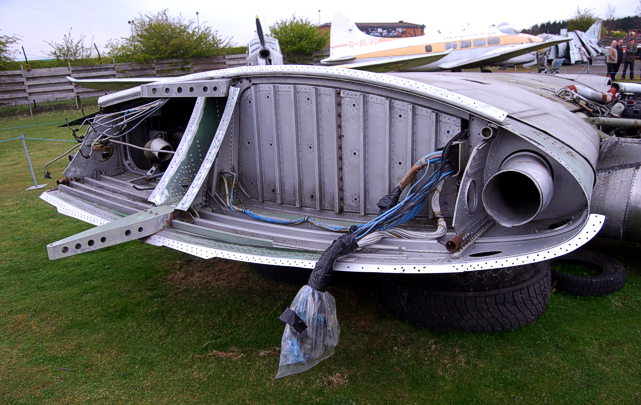Vickers Viscount Network first get together
The gathering on 19 April 2008 was a great success

From left to right - Julian Bourn, Michael Blank, Peter Upton, Adrian Fellingham, Mark Johnson,
Brian Burrage,
Ed Jones, Chris Jones, Geoff Blampied, Mark, Martin Garrett,
Rob MacSkimming, George Stringer and Alex Burton
A report by Brian Burrage
Although the weather was not ideal it was thankfully dry when members of the Vickers Viscount Network and their supporters
met at MAM - Midland Air Museum, Baginton, Coventry England on Saturday 19th April 2008. We were welcomed by Martin Garrett
of the Viscount 35 Association in company with Rob MacSkimming.

Viscount c/n 35 F-BGNR 'Victoria Lynne'
Martin took us to the museum’s meeting room which was nicely heated, a relief from the biting easterly wind and gave us a
splendid talk on the story of Viscount c/n 35 from its acquisition to its transfer to the museum site plus a potted history
since construction. All this was supported by photos and data displayed using a laptop and video projector. Martin’s fiancée
Katie had kindly put the powerpoint presentation together but unfortunately couldn’t make it on the day.
Eleven Viscount fans attended, namely: -
Geoff Blampied - 'Vickers Viscount Network' Co-founder and Webmaster
Brian Burrage – 'Vickers Viscount Network' Co-founder, Historian and Image Co-ordinator
Julian Bourn – History researcher specialising in the BEA / Cambrian / BA fleets
Ed Jones – History researcher and image contributor
George Stringer – Image contributor
Alex Burton – Image contributor
Peter Upton – Image contributor
Michael Blank – Image contributor
Chris Jones
Mark Johnson
Adrian Fellingham

George and Alex, ex BMA engineers, keep their hand-in by fixing the baggage door lock
After the talk and answering numerous questions Martin took us out to the aircraft which is currently lying on support
stands, and in small groups allowed us inside through the rear baggage hold door to view the condition of the cabin and
cockpit.
As the aircraft is still in a dismantled condition this was a rare opportunity to see and photograph all the features
normally hidden away, and in particular the way that the wings join the fuselage which seems extremely delicate considering
the size involved.
The next phase in the restoration will be the re-assembly and placing of the three undercarriage units onto the specially
constructed concrete pads that are already in place. This is scheduled to take place at the end of May and will then allow
the aircraft to be prepared for re-painting to give it the necessary protection from the elements. A final choice of colour
scheme has not yet been decided and Martin is open to suggestions at the moment and ideally some form of sponsorship to
cover the costs of the material.

The Viscount is in remarkably good condition
Considering the time that this aircraft has spent outdoors and idle, it is in remarkably good condition. Martin however,
emphasizes the enormity of the task ahead which even with help from other volunteers will take many years to complete.
An aircraft of this type is much harder to restore than say an F-4 Phantom, as people will expect to be able to visit the
cabin and to see it in all its glory which will involve a degree of electrical serviceability. The aim of getting one of
the original Rolls-Royce Dart RDa3 engines running is a possibility but a long way down the list of objectives.
Martin and his colleagues are to be applauded in not only saving this aircraft from destruction but for carefully planning
its future in a measured and structured way. We all wished him well in this mission and pledged our support in whatever way
we can.

Julian Bourn – history researcher specialising in the BEA, Cambrian, and BA Viscounts
is a BA - British
Airways Boeing 777 Captain and ex F-4 Phantom pilot
 History and photos of Viscount c/n 35 F-BGNR
History and photos of Viscount c/n 35 F-BGNR



